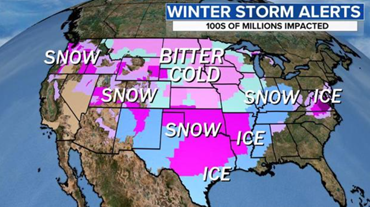There has been a lot of heated discussion about the recent weather-related electricity crisis in Texas. In case you somehow missed it, the temperature in much of the southern United States dropped to very unusual lows for several days in a row in February 2021. The low temperatures caused snowfall and freezing rain in many areas, creating havoc on the roads for drivers with neither winter driving experience nor snow tires.

Much worse, however, were the problems stemming from increased energy demand as people tried to heat their un-insulated homes – homes designed more for keeping heat out than keeping it in. The sudden spike in demand stressed the electricity grid beyond normal expectations. To avoid full-scale failure, authorities implemented pre-emptive rolling blackouts.
The chaos that followed included power outages for as many as 36 hours at a time, and frozen and burst pipes. Resulting low pressure left people without water, and allowed bacteria to enter the drinking water system, necessitating boil-water orders and bottled-water distribution. Tragically, there were several deaths attributed to the crisis as people tried to stay warm; some from fires in their homes, others, running their car engines, died from carbon-monoxide poisoning.
In social media feeds around the world, there was suddenly a multitude of armchair electricity grid experts. Enthusiastic amateur explanations (not without a certain amount of righteousness) range from a failure of green energy, to corporate mismanagement and greed, to political incompetence and bad civic planning. Without claiming to be electricity experts, we can at least look at what the data reveals.
Chart 1 shows electricity generation in Texas broken down by energy source from January 17 to February 20. The temperature (in degrees Fahrenheit) at Dallas/Fort Worth International Airport is overlaid for reference. When the temperature dipped drastically, around Feb. 9, the proportion of energy sources changed from a fairly balanced mix of wind, natural gas, solar, coal and nuclear, to domination by natural gas.
Grouping energy sources by type – fossils and renewables (excluding “other” and nuclear) – we see in Chart 1 (second tab) the dominance by fossil fuels when the weather became cold. The severe drop in the natural gas contribution at the end of the period (when temperatures were still below normal), was due to a number of factors, which were then exacerbated by power outages at gas plants. Was this a failure of renewables, as some headlines claimed? Superficial conclusions may be drawn from this, but that is not the whole story.
Chart 1: Ungrouped and grouped (tabbed)
We can look at the data in a couple of other ways to learn more about the different energy sources and their contributions and reliability. Chart 2 displays the same data, but with each energy source plotted as a percentage of its contribution to the total electricity output of that day. This again shows that on Feb. 9, natural gas began to dominate, rising from an average of about 30% of the total to close to 70% during the coldest period.
Chart 2: Ungrouped and grouped
Grouping the fossil fuels and the renewables together (Chart 2, second tab), this graph reveals an almost perfect mirroring of renewable (primarily wind) and fossil fuel (primarily natural gas) contributions throughout. It is easy to deduce from this picture, that when the wind blows, wind energy is prioritized, but when it does not blow, natural gas picks up the slack, regardless of temperature. This relationship was consistent throughout the coldest period as well, but the demands were just too great for the whole system to meet.
The wind contribution dropped drastically through the coldest period. Either the wind did not blow or the wind turbines did not function – with weather taking the blame in both scenarios. Regardless of arguments on other grounds for or against wind vs. natural gas, both perform just fine in cold climates with the appropriate cold-weather preparations and engineering (e.g. Norway, Denmark, Canada, and Germany all have wind farms, and temperatures in those countries routinely get below freezing).
Chart 3 shows each energy source’s contribution to the mix, but as a percentage relative to itself. In other words, how well did each source perform relative to its own maximum contribution within the period shown? Nuclear is extremely stable, providing 100% of its maximum output for all but a few days when the temperature dropped below 0°F. Coal also remained fairly constant, dropping below its average for only a few of the coldest days. Wind and solar dropped considerably as soon as the temperature dipped below freezing (32°F) on Feb. 9. Natural gas was at its maximum contribution throughout the below-freezing period. Interestingly, hydro, which is a tiny contribution to the overall energy mix in Texas (barely registering on Charts 1 and 2), also increased its output when the temperature dropped. There apparently was some excess hydro-electric capacity to draw upon, and every bit helped during this stressed situation.
Chart 3
Was this a “made in Texas” problem, or an energy mix problem? Let’s compare similar data in other states: California, during its own electricity crisis in August of 2020, and other southern U.S. states that experienced record-breaking low temperatures in February.
Alarming headlines in California read: “Bay Area’s brutal heat wave might be the new normal thanks to climate change”[1] and “California Blackouts a Warning for States Ramping Up Green Power”.[2]
Regardless of the underlying cause, California’s crisis was due to a period of higher-than-normal temperatures, during which people were drawing more electricity from the grid to cool their homes and businesses and schools. Can August in California be compared to Texas in February?
Looking at similar charts for California through the heat wave, we see that, as in Texas, natural gas compensated for a corresponding drop in renewables during the increase in demand (Charts 4 and 5). Chart 6 shows that coal was also ramped up while wind and solar dropped from their maximum contributions during the period.
Chart 4: Ungrouped and grouped
Chart 5: Ungrouped and grouped
Chart 6
Hydro is more significant in California than Texas; California has 271 hydroelectric facilities[3] and Texas has 23.[4] This discrepancy is due to natural topography and river flow. However, on Aug. 24, the hydro contribution in California almost doubled from the previous day and continued at that level for the rest of the time period. California occasionally draws power from the Hoover Dam in neighbouring Nevada and, in addition to extra capacity locally, this may have contributed to the increase during a time of need.
The daily high temperature in Los Angeles is shown on the California charts for reference, although temperatures inland and in northern California reached up to 30°F higher, and the heat wave lasted longer. On Aug. 16 the mercury hit 130°F in Death Valley, reportedly the highest recorded on planet Earth (although this distinction has yet to be confirmed).[5]
Returning to winter, what about Texas’s southern neighbours Louisiana, Mississippi, and Alabama, all of whom experienced similar cold spells? There were some power failures, less due to failure of the electricity grid and more due to storm damage of specific power infrastructure. Residents were asked to conserve energy as a precaution, but there were no widespread, deliberate electricity cuts.
The charts show even more of a reliance on fossil fuels in the three states for which data was available – Mississippi, Alabama, and Georgia. This is referred to as the Southeast Region by the U.S. Energy Information Administration (EIA), and data for these three states is grouped together. (Louisiana is grouped into the “Midwest” region, which extends all the way to the Canadian border, so data for that region will be ambiguous.) Chart 7 shows the mix; in this region, coal is more significant than the other two areas mentioned, there is no wind generation and solar is minimal. Hydro provides the largest renewable contribution to the grid, with a consistent nuclear baseline as in the other regions.
Chart 7: Ungrouped and grouped
Grouping the energy sources by type (Chart 7, second tab), we see the dominance of fossil fuels, regardless of demand. The temperature for Jackson, Mississippi, is shown on the chart for reference, demonstrating a pattern similar to Texas, but not as extreme.
Chart 8 shows the relative contribution of each energy source to the total. During the cold snap, it was coal that ramped up considerably to meet the demand, while the natural gas contribution fell. Fossil fuels are constant at about 75%, with renewables contributing less than 10% of the mix. Hydro ramped up somewhat, and nuclear dipped slightly during the coldest period, both responses consistent with these energy sources in the other two regions.
Chart 9 emphasizes the variability of solar in this region when compared against its own performance. This is contrasted with the relative stability of nuclear and hydro, the growth of the coal output, and the drop in natural gas.
Chart 8: Ungrouped and grouped
Chart 9
The pie charts below summarize the energy mix in each region, averaged over two time periods: normal demand and the period that would be considered stressed, whether it was hotter than normal or colder than normal. The size of the pies themselves are by population. The population of California is about 39,500,000; Texas, 29,000,000; and Mississippi, Alabama, and Georgia combined are 18,500,000.
These graphically reveal the natural gas reliance in each of the three regions and the significant increase in the natural gas component in times of extreme electricity demand for two out of the three regions. See other BIG Media articles (Renewable Energy Part 1 – renewing hope or struggling to cope and Part 2 – cost and economic viability, and Realistic Climate Change policy) for practical and pragmatic discussion of energy considerations beyond the regions discussed in this piece.
Pie Charts
Human civilization is very dependent on electricity; it is an essential component of our modern lives. Heating or cooling, charging phones and computers, powering data, businesses, banking, and transportation. We cannot do without it for long.
The Texas electricity authority is called, perhaps ironically, the “Electricity Reliability Council of Texas”. A good first step in ensuring reliability going forward is a careful, impartial look at the data.
[1] https://www.sfchronicle.com/news/article/Extreme-heat-waves-almost-always-have-a-human-15490661.php
[2] https://www.wsj.com/articles/california-blackouts-a-warning-for-states-ramping-up-green-power-11597706934
[3] https://ww2.energy.ca.gov/almanac/renewables_data/hydro/index_cms.php
[4] https://stateimpact.npr.org/texas/tag/non-wind-and-non-solar-renewable-resources/#:~:text=Today%2C%20hydropower%20accounts%20for%20only,in%20times%20of%20peak%20demand
[5] https://www.nps.gov/deva/learn/news/summer-2020-heat-records.htm#:~:text=DEATH%20VALLEY%2C%20CA%20%E2%80%93%20Over%20the,days%20ever%20recorded%20on%20Earth.&text=130%20degrees%20on%208%2F16,in%20the%20world%20since%201931
(Laurie Weston – BIG Media Ltd., 2021)


